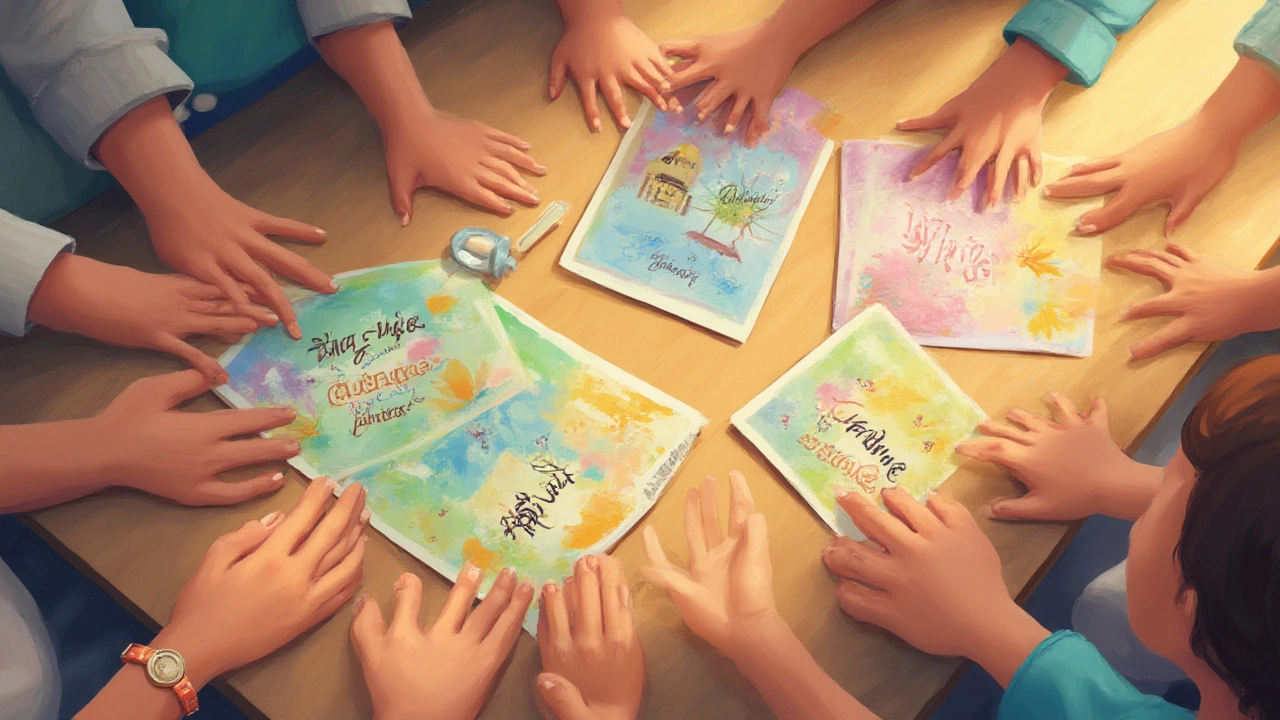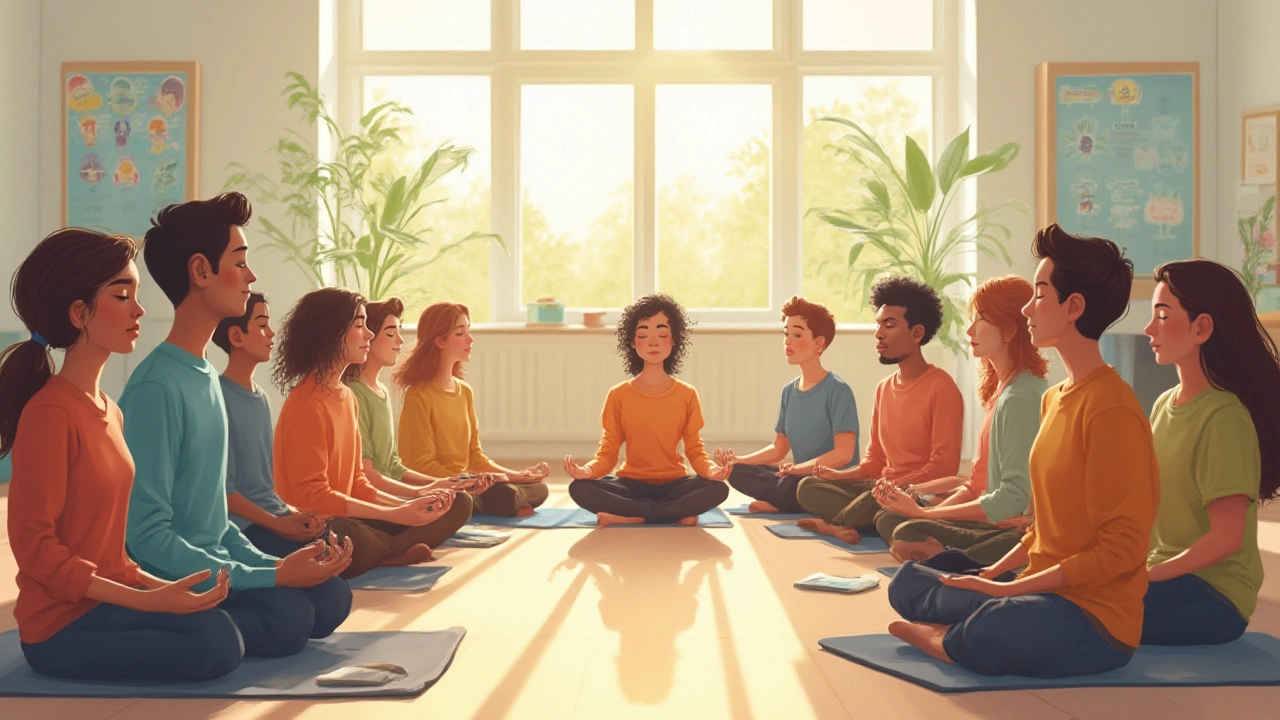It’s wild to think that in 2025, students practice meditation before tackling algebra, or teachers open classes with a few deep breaths and a moment of silence. Not because it’s a TikTok trend, but because of cold, hard science and growing evidence that mindfulness works. Gone are the days when such things belonged only in yoga studios or Saturday retreats. Now, schools worldwide are getting on board with a stronger focus than ever on mental health—and they’re not stopping at posters or assemblies.
Let’s say you step into a primary school in New York or a high school in Helsinki. It wouldn’t be weird to spot kids sitting with their eyes closed, quietly following their breath, or journaling their thoughts after some guided relaxation. Why? Because relentless academic pressures and digital distractions are frying young brains, not to mention rising anxiety and depression rates cropping up in the latest CDC data. Mindfulness is moving in with a promise: help students learn, but also help them feel okay while they do it.
Why Is Mindfulness Taking Over Classrooms?
When most people hear “mindfulness in education,” they imagine a bunch of squirmy kids forced to meditate. That’s not it. Mindfulness is much more about awareness, here-and-now presence, and tuning into what’s going on—inside and out. This isn’t just new-age fluff. Leading institutions, from Harvard to UCL, have been monitoring what happens when schools take mindfulness seriously. In 2014, a landmark study tracked over 6,000 kids in the UK and found that those with regular mindfulness training reported lower test anxiety, better attention, and less emotional blowout during stressful periods.
Fast forward to 2022. The largest US trial ever, spanning 12 states and 36,000 students, showed a 23% decrease in disruptive behaviors in classrooms that used daily mindfulness, along with a solid 18% improvement in reported student optimism. Teachers noticed students being less reactive, quicker to recover after setbacks, and for some, grades started to tick upwards—particularly in reading and math, where focus and calm matter most. There’s something about quieting the brain for just five minutes a day that seems to cut through the chaos and stress.
What makes all of this suddenly so urgent? If you talk to teachers, they’ll tell you attention spans are shorter. Students are jittery, hyper-connected, and burnt out by the time they hit finals. According to the 2024 UNESCO Global Education Monitoring Report, student stress-related absences hit an all-time high in Europe last year—directly correlating with increased phone and social media use. Nothing seems to get through quite like simple breathing. Even the World Health Organization threw its weight behind classroom mindfulness programs, noting the sharp rise in adolescent anxiety and the need for daily tools—not just crisis counseling.
It’s not just about feeling better either. Mindfulness, when built into schools, helps form real-life skills. Ever tried to focus on a dull lecture, or stop yourself from flipping to Instagram during a boring moment? Mindfulness lets you notice the urge, pause, and maybe, just maybe, choose differently. That single moment makes a lifetime of difference for many teens. Schools are now banking on these benefits not just for good vibes, but as a route to sharper learning and stronger community bonds.
| Year | Country | Schools Involved | Reported Benefits |
|---|---|---|---|
| 2014 | UK | 76 | Lowered anxiety, better focus |
| 2018 | Australia | 42 | 40% decrease in classroom disruptions |
| 2022 | USA | 189 | Higher optimism, better grades |
This is where the magic happens: mindfulness isn’t just a “soft skill” anymore. Principals and parents see it as survival gear for a fast world. That’s why more schools are weaving it into homeroom routines, sports practices, and even language arts classes, making mindful awareness as common as morning announcements.

The Science Behind Mindfulness and Student Success
If your mind’s buzzing with questions—why does this stuff even work?—you’re not alone. Neuroscientists have been studying mindfulness for years, not on monks but on teens and kids. Turns out, even basic mindful breathing lights up the prefrontal cortex, the part that helps with decision-making and emotional control. Ever heard someone say, “Count to ten before you yell”? That’s basic mindfulness, and it’s now supported by brain scans. According to a 2023 MIT review, just four weeks of mindful practice showed significant changes in the amygdala, the area linked with stress and fear. This isn’t theoretical—it’s visible, measurable, and real.
Here’s a practical example: A teacher in California reported her third graders used “belly breathing” before math quizzes. Results? Scores improved slightly, but the more dramatic shift came from how kids handled mistakes. Instead of melting down or acting out, they paused, breathed, and tried again. Mindful kids aren’t perfect; they just recover faster, and science backs it up. A Singapore study in 2020 scanned students who practiced mindfulness for three months, showing improved working memory—a direct link to better test results.
Mainstream curriculum is catching on. MindUP, a popular program backed by the Dalai Lama and Goldie Hawn, now reaches over six million students in 11 countries. What’s so special about it? It mixes short breathing exercises, gratitude journals, and frank brain science—teaching kids not just to calm down but why their brains react the way they do. It’s like mental gym class for growing minds. Even Finland’s famously chill schools (they’re always top on education lists) now require some daily mindful movement, proving mindfulness isn’t exclusive to stressed-out schools; it can supercharge even great systems.
You might wonder if it’s all just a feel-good fad. Sure, some skeptics say it’s “one more thing” piled onto the school day. But evidence says otherwise. In 2021, Oregon’s statewide pilot saw a 52% drop in teacher burnout where mindfulness programs were consistent. When teachers are less frazzled, everyone benefits. Chronic stress is contagious, after all. Administrators even noted better attendance and a noticeable boost in campus morale, not to mention a decrease in lunchroom drama and more peaceful playgrounds.
Mindfulness isn’t a cure-all. It won’t fix broken school funding or solve every problem, but it helps create a baseline of emotional stability. These days, that simple, steady ground is less luxury and more necessity. Like recess and art class, mindful moments can fuel not just academic achievement but real joy and resilience.
- Regular practice—just five minutes per day—can shrink the stress hormone cortisol in both students and teachers.
- Kids who score high on “present moment awareness” report better sleep and more energy after school.
- A group of Portland middle schools found suspension rates dropped by one-third after adding a daily mindful check-in.
- Students in mindfulness programs had a 17% higher rate of turning in homework on time, according to Stanford’s 2022 tracking study.
So, science says it’s legit. Teachers, parents, and kids notice real change. Now comes the savvy part: how do you make mindfulness work in everyday classrooms, and not as another box to tick off?

Practical Ways to Bring Mindfulness Into the Classroom
Every school has its own culture and vibe. Mindfulness isn’t a one-size-fits-all solution, but it’s adaptable. You can go big—launch a whole-school program like MindUp or Inner Explorer—or just sprinkle a few practices through the day. What matters is that it feels natural, not forced. Want concrete ideas? Here’s what’s working right now in real schools:
- Start Small: Teachers report less pushback from students and parents when they open with five-minute “mindful moments.” This could be a breathing exercise, body scan, or one minute of silent listening to the sounds in the classroom.
- Journaling and Gratitude Lists: Some classrooms keep stacks of sticky notes for “thankful Thursdays.” Kids jot down something, pop it in a jar, and read a random one at the end of the month. Not only does it lift moods, it builds a habit of noticing good stuff happening—even on rough days.
- Movement Matters: Not every kid likes to sit still. Active mindfulness works too: slow walking activities (“notice your feet touching the floor”) or gentle stretches. Elementary schools in Ontario use “mindful walking” after recess to help kids transition back to learning mode.
- Technology Boosts, Not Barriers: There’s a myth that you must lock up phones to stay mindful. The newer approach? Use apps that guide short, kid-friendly meditations or send gentle reminders for posture breaks. Teachers at a pilot school in Austin reported better participation when tech was used as a support, not a distraction.
- Peer-to-Peer Mindfulness: Some high schools use older students as “mindfulness mentors,” who lead small sessions for younger grades. It’s less intimidating and builds student leadership at the same time. Peer programs in Colorado saw not only more buy-in but also a stronger sense of school community—students felt seen and supported.
- Integrate, Don’t Isolate: Best results come when mindfulness pops up in different subjects—not just health class. Math teachers might begin with a focus exercise before tests; language arts classes might try reflective reading. A Boston literature teacher used poetry analysis as a mindful exercise, asking students to pause and reflect on lines quietly before sharing.
One real-world success story comes from a middle school in Chicago that struggled with constant disruptions. They adopted a simple three-step protocol: a mindful minute at the top of every period, weekly “circle check-ins” to share feelings without judgment, and a dedicated “Calm Corner” with cushions and coloring books. By spring, referrals for classroom outbursts dropped 41% and more kids said they looked forward to school. Not magic—just mindful intention, structure, and clear follow-through.
Let’s talk roadblocks. Some teachers feel awkward or anxious leading mindfulness—especially if they don’t practice it themselves. The trick? Start together. Administrators noticed better outcomes when teachers join peer groups or have access to quick trainings. Several large districts now offer optional thirty-minute workshops (most on Zoom!) to get teachers comfy before introducing anything to students. The learning goes both ways.
Family involvement works wonders, too. When parents are in on the approach, the benefits deepen. Schools who send home short audio tracks or mindful activity cards get way more engagement and build habits beyond the classroom. One Seattle elementary school sent home “mindful bedtime” routines that doubled as nightly homework for second graders. Kids reported calmer sleep—and so did parents.
Adaptation beats perfection every time. Some students gravitate to mindful coloring; others would rather walk; a few thrive on simple deep breaths. The only rule? Make space for choice. Let students have a say in how they want to try mindfulness. The more ownership, the more likely it’ll stick for the long haul.
| Age Group | Popular Mindfulness Activities |
|---|---|
| Early Elementary | Bell/breathing, sensory jars, story-based body scans |
| Middle Grade | Gratitude journals, mindful walks, peer check-ins |
| Teen/High School | App-based meditations, mindful debate, calm corners |
All you need is willingness to try, small steps, and patience for figuring things out. This isn’t about making every kid a little Buddha. It’s about giving young people tools that might just save them from overwhelm—and help them actually enjoy learning. Mindfulness is more than a school trend. When schools adopt mindful practices, they’re not just boosting grades, they’re changing lives. And isn’t that what education’s really for?






